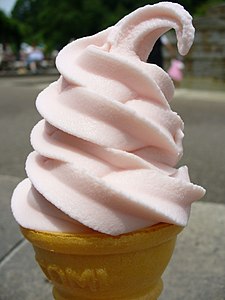Soft serve: Difference between revisions
m Date maintenance tags and general fixes |
No edit summary |
||
| Line 3: | Line 3: | ||
== History == |
== History == |
||
A chemical research team in [[United Kingdom|Britain]] (of which a young [[Margaret Thatcher]] was a member)<ref>[http://www.number10.gov.uk/history-and-tour/prime-ministers-in-history/margaret-thatcher Margaret Thatcher<!-- Bot generated title -->]</ref><ref>[http://www.kzwp.com/lyons/ J. Lyons & Co<!-- Bot generated title -->]</ref> discovered a method of doubling the amount of air in ice cream, which allowed manufacturers to use less of the actual ingredients, thereby reducing costs. This ice cream was also popular amongst consumers who preferred the lighter texture, and most major ice cream brands now use this manufacturing process. {{Fact|date=March 2008}} It also made possible the soft ice cream machine in which a cone is filled beneath a [[Tap (valve)|spigot]] on order. In the United States, [[Dairy Queen]], [[Carvel]], and [[Tastee-Freez]] pioneered in establishing chains of soft-serve ice cream outlets. |
A chemical research team in [[United Kingdom|Britain]] (of which a young [[Margaret Thatcher]] was a member)<ref>[http://www.number10.gov.uk/history-and-tour/prime-ministers-in-history/margaret-thatcher Margaret Thatcher<!-- Bot generated title -->]</ref><ref>[http://www.kzwp.com/lyons/ J. Lyons & Co<!-- Bot generated title -->]</ref> discovered a method of doubling the amount of air in ice cream, which allowed manufacturers to use less of the actual ingredients, thereby reducing costs. This ice cream was also popular amongst consumers who preferred the lighter texture, and most major ice cream brands now use this manufacturing process. {{Fact|date=March 2008}} It also made possible the soft ice cream machine in which a cone is filled beneath a [[Tap (valve)|spigot]] on order. In the United States, [[Dairy Queen]], [[Carvel]], and [[Tastee-Freez]] pioneered in establishing chains of soft-serve ice cream outlets. In the United Kingdom the [[Ice Cream Van]] is a popular summer vendor of cones; often served topped with strawberry sauce, [[sprinkles]] or a [[99 Flake]]. |
||
==Pre-mix== |
==Pre-mix== |
||
| Line 25: | Line 25: | ||
*[[Frozen yogurt]] |
*[[Frozen yogurt]] |
||
*[[Tasti D-Lite]] |
*[[Tasti D-Lite]] |
||
*[[Ice cream van]] |
|||
[[Category:Ice cream]] |
[[Category:Ice cream]] |
||
Revision as of 20:51, 18 March 2009

Soft serve, or creemee in parts of the northeastern United States, is a type of frozen dessert that is softer than ice cream.
History
A chemical research team in Britain (of which a young Margaret Thatcher was a member)[1][2] discovered a method of doubling the amount of air in ice cream, which allowed manufacturers to use less of the actual ingredients, thereby reducing costs. This ice cream was also popular amongst consumers who preferred the lighter texture, and most major ice cream brands now use this manufacturing process. [citation needed] It also made possible the soft ice cream machine in which a cone is filled beneath a spigot on order. In the United States, Dairy Queen, Carvel, and Tastee-Freez pioneered in establishing chains of soft-serve ice cream outlets. In the United Kingdom the Ice Cream Van is a popular summer vendor of cones; often served topped with strawberry sauce, sprinkles or a 99 Flake.
Pre-mix
Pre-mix can be obtained in several forms:
- Fresh liquid that requires constant refrigeration until needed. It can be stored for 5 to 7 days before spoiling by bacterial contamination. Quality can be severely compromised by bacterial contamination and handlers must exercise caution to maintain quality.
- Powdered mix. This is a dried version of the liquid mix. It has the advantage of easy distribution and can be stored for long periods of time without spoiling. Water must be added prior to being churned and frozen. The disadvantage is that water quality cannot be guaranteed and some operators can put too much water in to make it go further. It also should be refrigerated to 3 degrees Celsius prior to use, as airborne and waterborne bacteria can infect it immediately and can grow quickly if the product is warm. Residual bacteria in the refrigerated storage compartment can also be activated by warm product being introduced.
- Ultra Heat Treated mix is a liquid that has been sterilized and packed in sealed, sterile bags. It can last a very long time without refrigeration and can be poured into the soft serve freezer immediately upon opening. However it should be refrigerated to 3 degrees Celsius prior to use for the same reasons outlined above. At the time of opening, quality can be guaranteed and bacterial counts are zero. Where it is available, health authorities consider it the safest form of soft serve mix on the market. It was first developed for commercial use in New Zealand in 1988 in a joint venture between Tatua Foods, a dairy company and Bernie Cook, owner of Blue Boy, a mobile franchise network.

Terminology
- Creemee is another term for soft-serve ice cream which is mostly used by people from upstate New York, Vermont, parts of Massachusetts, and Connecticut.
- Softcream (ソフトクリーム, sofutokuriimu) is used to describe an analogous product in Japan, that can be either savory or sweet, with uniquely[citation needed] Asian flavors such as wasabi, sesame, ume or plum, rose, kabocha or Japanese pumpkin, peach, and grape, among others. In Japan, July 3 is Softcream Day (ソフトクリームの日, sofutokuriimu no hi), commemorating the introduction of soft ice cream to Japan at an Independence Day celebration by the United States Armed Forces in 1951
